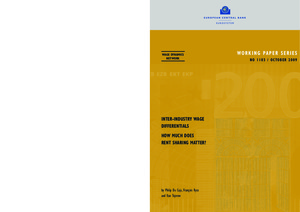Inter-industry wage differentials: how much does rent sharing matter?
"This paper investigates inter-industry wage differentials in Belgium, taking advantage of access to a unique matched employer-employee data set covering all the years from 1999 to 2005. Findings show the existence of large wage differentials among workers with the same observed characteristics...
| Main Authors: | , , |
|---|---|
| Institution: | ETUI-European Trade Union Institute |
| Format: | TEXT |
| Language: | English |
| Published: |
Frankfurt am Main
2009
ECB |
| Subjects: | |
| Online Access: | https://www.labourline.org/KENTIKA-19178287124919964699-inter-industry-wage-differenti.htm |
| Summary: | "This paper investigates inter-industry wage differentials in Belgium, taking advantage of access to a unique matched employer-employee data set covering all the years from 1999 to 2005. Findings show the existence of large wage differentials among workers with the same observed characteristics and working conditions, employed in different sectors. These differentials are persistent and no particular downward or upward trend is observed. Further results indicate that ceteris paribus, workers earn significantly higher wages when employed in more profitable firms. The time dimension of our matched employer-employee data allows us to instrument firms' profitability by its lagged value. The instrumented elasticity between wages and profits is found to be quite stable over time and varies between 0.034 and 0.043. It follows that Lester’s range of pay due to rent sharing fluctuates between about 24 and 37 percent of the mean wage. This rent-sharing phenomenon accounts for a large fraction of the industry wage differentials. We find indeed that the magnitude, dispersion and significance of industry wage differentials decreases sharply when controlling for profits." |
|---|---|
| Physical Description: | 74 p. Digital |

